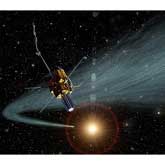The Brave and Cold Ulysses
 Deep space is cold. Very cold. That's a problem--especially if you're flying in an old spaceship. And your power supplies are waning. And the fuel lines could freeze at any moment. Oh, and by the way, you've got to keep flying for thirteen more years. It sounds like a science fiction thriller, but this is really happening to the spacecraft Ulysses. Ulysses was launched in 1990 on a five-year mission to study the sun. The craft gathered new data about the speed and direction of the solar wind. It discovered the 3D shape of the sun's magnetic field. It recorded solar flares on the sun, and super-solar flares from distant neutron stars. Ulysses even flew through the tail of comet Hyakutake, an unexpected encounter that delighted astronomers. The mission was supposed to end in 1995, but Ulysses was too successful to quit. NASA and the ESA have granted three extensions, most recently in Feb. 2004. Ulysses is scheduled to keep going until 2008, thirteen years longer than originally planned.
Deep space is cold. Very cold. That's a problem--especially if you're flying in an old spaceship. And your power supplies are waning. And the fuel lines could freeze at any moment. Oh, and by the way, you've got to keep flying for thirteen more years. It sounds like a science fiction thriller, but this is really happening to the spacecraft Ulysses. Ulysses was launched in 1990 on a five-year mission to study the sun. The craft gathered new data about the speed and direction of the solar wind. It discovered the 3D shape of the sun's magnetic field. It recorded solar flares on the sun, and super-solar flares from distant neutron stars. Ulysses even flew through the tail of comet Hyakutake, an unexpected encounter that delighted astronomers. The mission was supposed to end in 1995, but Ulysses was too successful to quit. NASA and the ESA have granted three extensions, most recently in Feb. 2004. Ulysses is scheduled to keep going until 2008, thirteen years longer than originally planned.
Ulysses' extended mission, as before, is to study the sun. But at the moment Ulysses is far from our star. It's having an encounter with Jupiter, studying the giant planet and its magnetic field. Sunlight out there is 25 times less intense than what we experience on Earth, and Ulysses is getting perilously cold. Back in the 1980's, when Ulysses was still on Earth and being assembled, mission planners knew that the spacecraft would have to endure some low temperatures. So they put dozens of heaters onboard, all powered by a Radioisotope Thermoelectric Generator, or
Fuel lines are critical to the mission. They deliver hydrazine propellant to the ship's eight thrusters. Every week or so, ground controllers fire the thrusters to keep Ulysses' radio antenna pointing toward Earth. The thrusters won't work if the hydrazine freezes. No thrusters means no communication. The mission would be lost. About eight meters of fuel line snake through the spaceship. Every twist and turn is a possible cold spot, a place where the hydrazine can begin to solidify. The temperature at any given point along the fuel lines is bewilderingly sensitive to what's going on elsewhere in the spacecraft. Turning on a scientific instrument
About the Author
NASA Marshall Space Flight Center
 The George C. Marshall Space Flight Center, located in Huntsville, Alabama, is the U.S. government's civilian rocketry and spacecraft propulsion research center. As the largest NASA center, MSFC's first mission was developing the Saturn launch vehicles for the Apollo program.
The George C. Marshall Space Flight Center, located in Huntsville, Alabama, is the U.S. government's civilian rocketry and spacecraft propulsion research center. As the largest NASA center, MSFC's first mission was developing the Saturn launch vehicles for the Apollo program.


